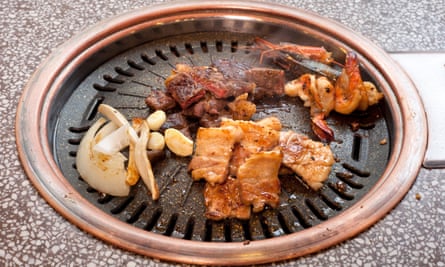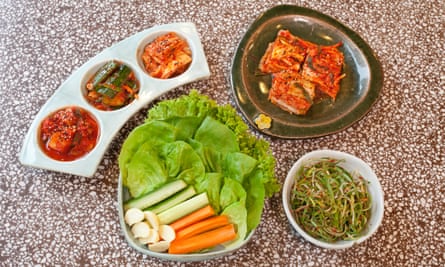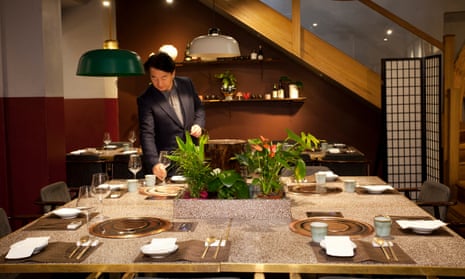Olle, 88 Shaftesbury Avenue, London W1D 6NG (020 7287 1979). Small plates £6-£12.50; larger dishes £11-£54.50; wines from £19
Olle Korean barbecue on London’s Shaftesbury Avenue has a shop window which puts the gorgeous displays of diamanté alligators and glass slippers over at Fortnum & Mason on Piccadilly to shame. I’ve walked past Olle’s brightly lit picture windows countless times over the past year, and the view has always been intoxicating: diners at broad communal tables, hunched over electric grill plates, tending to sizzling pieces of meat, fish and vegetables as if they were holy relics. It’s dinner with a floor show. I knew it was only a matter of time before I would become one of those diners.
And now, here I am, blinking furiously, because I’ve worked out how this enticing shop window display thing works. Bloody hell, it’s bright in here. I feel like I could get a tan just sitting at the table. Not only do the diners look like they are on display from the outside. It feels as if you’re on display when you become one of them on the inside. And so, to my first tip: there’s a downstairs dining room, which I only discovered when I went to the loo. It’s still bright down there, but it’s not encased in glass.

I have that taste’: meats and prawns for barbecue. Photograph: Sophia Evans/The Observer
You get used to it in the end, thankfully, because this restaurant is worth the effort. “Olle” is apparently the word for a path, in the dialect of an island off the coast of South Korea, though there doesn’t seem to be anything particularly regional or niche about the offering here. If you’ve been to a Korean restaurant before, the menu will be broadly familiar. They just do it very well and, most importantly, with an uncommon grace and charm.
A decade ago, during an extended stay in Los Angeles, I found my way to Soot Bull Jeep, one of the last barbecue places in Korea Town still to use red-hot guttering coals rather than an electric hot plate. It was dark in there – and smoky – and buckets were strategically placed to deal with plumbing leaks. It gave the whole thing a pleasingly raffish, Blade Runner vibe. Most memorably, the dining room was overseen by furrow-browed Korean women who seemed furious with me for coming at all. They huffed every time they tended my grill. I’m sure the fact I kept returning for dinner didn’t help.
The staff at Olle seem genuinely pleased to see us. They want to help, which is good because, as I’ve observed before, there can be an awful lot of admin with Korean food. It’s literally high maintenance. The one bit of help they don’t give is a warning that we should order what we want when we want it, rather than at the start. Because if you order it, they will bring it. All at once. We have the corner of an eight-seater communal table and it quickly fills with bowls and dishes of sauce, with salads and servings of rice. I find myself apologising for the lack of space when actually it’s their fault.

Alongside the ingredients for barbecuing, which we’ll come to, there are many standards. Their Korean fried chicken is everything I want it to be, with a double fried crunch that creates ricocheting echoes in every cranial hollow and cavity, followed by the confectionery-shop slap of the sweet-savoury sauce. Korean fried chicken is the food world’s undercover agent. Because it represents a culture about which many of us feel we know relatively little, it gets a free pass on to our plates for being gently exotic. Health concerns do not figure. In truth, nutritionally, this KFC is on a par with something you’d pick up at 2am from a south London branch of Morley’s chicken shop when you’re off your head on Diamond White. I mean all this in a very, very good way.
A seafood pajeon, a cross between a pancake and an omelette, is full of the crunch of still pert spring onions, the softness of mollusc and crustacean, and lots of crispy frilly bits. From the thoroughly virtuous side of the ledger comes a stew of seafood and ivory white cubes of tofu in a soybean paste broth. It’s a steamy and encouraging bowlful that feels as if it is determined to mother you, one spoonful at a time. At £11.90, including rice, it’s a substantial meal for one.
And then there is the grilling, on a round metal electric hot plate, sunk into the corner of the table. All the usual suspects are here: the bulgogi, or thinly sliced curls of rib eye, to be unfurled once on the heat; galbi, or slivers of short rib, served bone in; the thick slabs of fatty pork belly, and the well-marbled chunks of rib eye. They also have a list of wagyu cuts, at punishing prices: 100gm of Grade 5 rib eye costs £27.25. (Weirdly, this is very good value; at Restaurant 34 it’s £45 for the same weight, and at Cut it’s £70).

Instead, go for one of the selections. Ours costs £54.50, includes various meats plus prawns the length of my hand, a pokey salad of shredded spring onions, slabs of onion and king oyster mushroom, plus soya bean paste and sesame oil dips. There is easily enough for three. Now the fun begins. We sizzle and we sear. Occasionally a waiter leans over to cut up pieces of meat that are otherwise too big for the metal chopsticks with which we have been supplied. The pork is for those with a taste for caramelised fat. I have that taste. We gnaw on beef rib bones, band-sawed when it was frozen. It is the slabs of rib-eye, charred outside and pink within, that are the stars. We are our own floor show. For those passing by outside we are also now the window display. A little smoke gets in our eyes and we like it like that. We drink a serviceable sauvignon, and hunker down.
We don’t even ask about dessert, because this isn’t the place. Instead we cross the road to somewhere I had also walked past repeatedly. I thought it was a bog-standard café knocking out boulders of dense and dispiriting cake. It turns out to be a franchised branch of Pompi, the tiramisu specialists from Rome. I have the classic tiramisu for £5.80. It is light and fluffy and creamy and spongy and utterly compelling. There is a heartening coffee kick and shortly after, an empty plate scraped to the glaze. Both Pompi and Olle are proof, if it were needed, that sometimes you really shouldn’t just walk on by.
News bites
Seoul Kimchi, a tiny restaurant by Manchester’s Royal Infirmary, was originally a place where Korean students could buy the foods of home, but eventually started cooking and serving it as well. It is basic but good: there are hearty seafood stews, fully stacked bibimbaps and, of course, lots of kimchi. Get booze from the nearby Tesco Express. Search for their page on Facebook.
The Cook Book Club, originally founded by food writer Thane Prince at the Drapers Arms pub in Islington, as a forum in which to meet cookery writers and share recipes, relaunches on 13 February. The guest speaker is Niki Segnit, author of The Flavour Thesaurus and Lateral Cooking. Entry is £10, including a glass of wine. Follow @DrapersCookClub on Twitter for event details and more information.
It’s all change at the Swan Inn, Esher, which has been run for the past three years by chef Claude Bosi and his brother Cedric. It has been taken over by chef José Pizarro and will re-open in early March with an all-Spanish menu.
Email Jay at jay.rayner@observer.co.uk or follow him on Twitter @jayrayner1

Comments (…)
Sign in or create your Guardian account to join the discussion